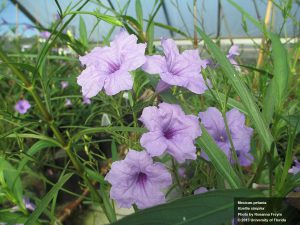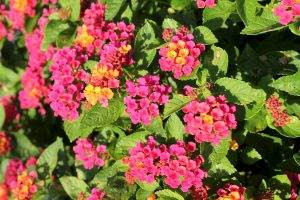An invasive plant is defined as a plant that is non-native to the ecosystem under consideration and whose introduction causes or is likely to cause economic or environmental harm or harm to human health (National Invasive Species Council, 2001). Research supports the fact that invasive plants damage natural areas, but there is great debate over which plants are invasive and where they are causing problems. Many lists of invasive plants have been complied by government agencies or environmental groups such as the Florida Exotic Pest Plant Council (www.fleepc.org) that include plants currently available at nurseries. Examples of such plants are Mexican petunia, Lantana and Porterweed.
The bright color and rapid growth of Mexican petunia (Ruellia tweediana or R. brittoniana) has resulted in mass plantings that disrupt native wetland systems. The species is not used by butterflies, contrary to published misinformation. On the other hand, Porterweed is attractive to butterflies and the deep blue flower color of Stachytarpheta urticifolia has proven to be equally popular with gardeners. Additionally, Lantana camara is a favorite of Lepidoptera and a prolific bloomer, so hundreds of plants are installed in the landscape annually, spreading viable seed throughout the neighborhood and woods. Unfortunately, when it is found in natural areas it is difficult to distinguish the native lantana (L. depressa) from the invasive lantana (L. camara) and the two species can hybridize, making accurate identification even harder.
In fact, all three plants have native cousins with acceptable growth habits. Drought tolerant Ruellia caroliniensis has a pale violet-colored flower that serves as a host plant to the Buckeye butterfly. Stachytarpheta urticifolia is a low-growing groundcover with pale blue flowers. If the Porterweed is growing tall and upright, it is not the native. Leaf characteristics can be used to distinguish the native lantana (L. depressa) from the invasive lantana (L. camara). Native lantana has a tapered leaf base, whereas the invasive lantana has a truncate leaf base.
Cultivars of species may have characteristics making them less invasive (Wood, 2007). University of Florida faculty has implemented an assessment process to evaluate non-native, highly utilized plants that are invading natural areas in Florida, including the marketed cultivars. The “UF-IFAS Assessment of Non-Native Plants in Florida’s Natural Areas” (IFAS Assessment) uses four criteria to categorize many of the plants available in the nursery trade. Over 700 species have been assessed (results are available at http://plants.ifas.ufl.edu/assessment/).
Some of the latest research included Lantana, Ruellia, and Stachytarpheta species. Each of them yielded a sterile cultivar that exhibited both the desired flowering of the invasive species while posing no threat to natural areas. When evaluated, these three cultivars scored well for minimal ecological impact, potential for expanded distribution, management difficulty and yet have a good economic value for the industry. So when looking for this year’s new garden introduction, one should consider ‘Purple Showers’ Ruellia, ‘Violacea’ Porterweed or ‘Patriot Cowboy’ Lantana. According to Dr. Gary Knox (UF/IFAS, North Florida Research and Education Center, Quincy, FL), they behaved well in the UF-IFAS assessment.
- April is Safe Digging Awareness Month - April 6, 2024
- Deck the Halls with Boughs of Holly - December 8, 2023
- The Long Flight South - October 5, 2023


